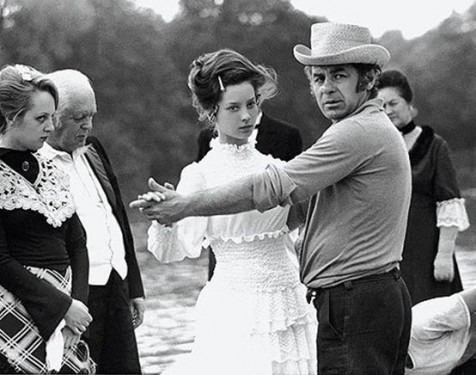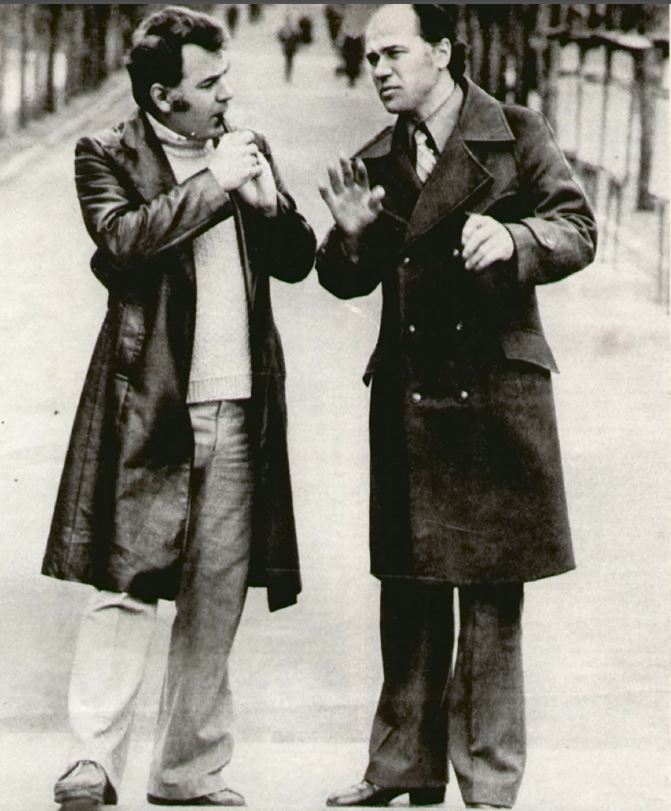You are here
The film My Sweet and Tender Beast and the legendary waltz turn 40. 31.07.2018
On July 31, 1978 film My Sweet and Tender Beast was presented to the public for the first time at the International Film Festival in Cannes as part of the main competition program.
The dramatic story about love and jealousy, passion and delusion,is based on Anton Chekhov's The Shooting Party.
Film production began in 1976. Initially, the film was meant to be called The Cage. But then Emil Loteanu decided to make the title less straightforward and also to edit the plot while maintaining "the feeling of an impending catastrophe, the eternal drama of contradiction between the yearnings of the soul and life circumstances."
The film was shot at the Valuyevo estate near Moscow, which took its final shapearound 1770, when it was owned by the historian and early text specialist Count Alexei Musin-Pushkin, who is known for having discoveredThe Tale of Igor's Campaign, The Testament of Vladimir Monomakh and other historical documents.
It is at this this antique estate with a classical-style house, sculptures, century-old trees, cascading ponds, and pavilions that the shooting began.
"The narrative no longer formed in my subconscious through words – I heard music and discerned colors. Words no longer frightened me with their burden – theysoared like birds in a new, independent quality. I felt this drama during hunting to be an opportunity for cinematic accomplishment. And whatever the outcome, I knew that I would be shooting a poetic picture based on Chekhov's score,"wrote Emil Loteanu in the magazineThe Soviet Screen.

Foto - Russia TV
The director was very particular about casting for the main character. He wanted Olga Skvortsova to be played by an actress who looked like Audrey Hepburn, Tatyana Samoilova, and Lyudmila Savelieva all at once, but at the same time had her own acting personality. It was not an easy task and took quite a while. Emil Loteanu’s assistant, Tamara Tavrizyan, brought him a small passport photo of Galina Belyaeva, a student at the Voronezh Choreography School. She immediately caught the director’s eye. She was 16 and had just completed her third year.
"For me it was certainly difficult – I was afraid of the camera, afraid to speak," recalledGalina Belyaeva in the program Alone with Everyone in 2014. She was the only debutante among the film crew that consisted of prominent actors known throughout the country, a famous filmmaker, and a famous composer.
Nevertheless, it was her that the director entrusted with the role of Olga Skvortsova. “The role is beautiful, complex, full of tragedy and charm,”wrote Lotyanu. Galina had to learn the basics of acting –horse-riding, dancing, crying, and much more. She managed it all with dignity, and this role made her famous throughout the Soviet Union.

The role of judicial investigator Kamyshevwas played by Oleg Yankovsky. “When Emil Loteanu offered me the role of Sergei Kamyshev, I had many doubts. I was familiar with The Shooting Party but after reading the script, I asked myself: what does Chekhov have to do with it? But I also knew Loteanu by his previous work,” he said.
The role of Count Karneev was played by Cyril Lavrov, and of Urbenin– by Leonid Markov.
Loteanu describes the relationship between these four characters of the story as follows: "What isThe Shooting Party? It's like four express trains that collide at full speed and derail."
The film also starred Svetlana Toma and Grigory Grigoriu who had already appeared in Loteanu’s films before.
The film’s soundtrack was composed by Eugen Doga. This was his third collaboration with Emil Loteanu.

“It all started when Emil Loteanu, the director of My Sweet and Tender Beast— our collaboration has been going on for more than ten years — asked me to compose music for the wedding scene of OlgaSkvortsova, the main character, which was the first scene to be shot.At the time when Chekhov’s The Shooting Partywas set, the waltz was just coming into fashion, timidly, with reservation... So, a waltz it will be ... And not even a waltz as such, but rather a game of waltz, the state of waltz, its spirit.Six months passed since the director and I agreed on the music,“says Eugen Doga. “Suddenly, like lightning, Emil Loteanu bursts into my hotel room at Mosfilm Studio. ‘The waltz! —he says, before even closing the door behind him —I have already forgotten about it, got busy with other films.’ I started strumming something random in the rhythm of the waltz, knowing that this was not what the director wasexpecting. I tried this and that... The director was not nervous anymore but ready to unleash all his anger on me. Seeing that a storm was coming, I grabbed a small sheet of music from the floor like a lifeline and played literally three notes, written by me as a reminder. Loteanu got into it quickly and, standing behind me, did not leave me alone until I improvised the waltz to the end. Without a word, he abruptly left the room, slamming the door so hard that it nearly fell off its hinges. Already going down the stairs, he loudly said that the recording had been arranged for the next day. There would be an orchestra and a choir, and the day after they would start shooting! Oh boy! My head started spinning. What was it that I’d played there? Ihadto rewind it all in my head! There was no time to think. The notes appeared on the blank score sheet on their own. There weren’t many as there was no time to write. And thank God. The score turned out to be transparent, watercolor-like. From the very beginningthe theme is accompanied by the gentle, lullaby-likebackground violins, which, as it were, comment on the complex contradictory feelings that occur in the characters’souls. Though, not a trace of this watercolor remainsin the piece’s finale, when the waltz approaches its climax, the apex of the impending drama. That’s where the choir joins in."
Emil Loteanu was one of the few directors who used a sound track during shooting. Eugen Doga offered a waltz for the wedding scene of OlgaSkvortsova, initially planning to find something similar to a waltz in the radio libraries or in the Glinka Museum. But there was nothing, not even the music lovers could help— in the 80s of the 19thcentury there were no recordings being done yet. After this discoveryit was concluded that the music for the scene would have to be composed independently. And so, one night in the beginning of summer, in a few hours Eugen Doga wrote a waltz which became the "cardiogram" of the film, as Loteanu calls it. In the morning the notes of the score were turned in, and in the evening of the same day the waltz was performed by the State Cinematography Orchestra of the USSR under the direction of Sergei Skripka. “I came to the recording studio; the orchestra played the music for the first time and suddenly, unexpectedly for me, the musicians started tappingon the music stands with their bows. I thought they were pranking or mocking me. I really thought it was a joke,”said the composer. The next day, the crew, lying on the grass, listened to this waltz dozens of times, thus delaying the start of the shooting. Only in the evening did the shooting begin.
The waltz changed the dramaturgy of the scene, said Doga: “I remember, at the climax of the waltz, the film's cameraman V. Nakhabtsev suggested ‘elevating’ the heroine! She was lifted onto the camera crane, from where she beautifully projected against the setting sun, as the embodiment of a metaphor, as a herald of a new era. The old decrepit manor and the old inhabitants of the passing landlord times remained below while a new world, symbolized by this young heroine played by Galina Belyaeva, rises over the departing old world.”
The film was released to the Soviet public on September 18, 1978 and became one of the blockbusters. It was watched by 26 million viewers and became the most spectacular and successful movie adaptation of Chekhov's works.
And the waltz was immediately loved throughout the country, and lateracquired world fame.
“Of course, I was not indifferent to this and simply pleased: I will never forget the huge line at the music store on the Garden Ring, where vinyl records with My Sweet and Tender Beast soundtrack, that had just been released by Melodia, were being sold,” recalled the composer.
Since then, this waltz has been played everywhere: in school classrooms and kindergartens, at concerts and performances, in music stores, at sporting events, at celebrations and balls; newlyweds often choose it for their first wedding dance. It sounded at the opening of two Olympic Games (Moscow-1980 and Sochi-2014) and at the presentation of the 2018 FIFA World Cup at the UN headquarters in New York. It is called the most famous ‘film waltz’ in the world and it has been included in various compilations of top music compositions of all time.
The waltz is performed on the subwayand in underground passages, in the streets... Once a street musician who was playing this waltz at the entrance of the Louvrein Paris told a Moscow journalist that he was playing an old French waltz. Newlyweds and graduates whirl to this waltz; it sounds on the radio and television; it is performed on a variety of instruments and by different orchestras and ensembles.
The waltz’s melody was rung by the bells of the Peter and Paul Fortress;to its tune move the fountains jets of the Mimi Castle in Moldova and of the Sochi Olympic Park, as well as fountains in Abrau-Dyurso, Tashkent, Ferrara, and St. Petersburg. It has been performed by various orchestras in huge concert halls for 40 years.
Dancing to this music, figure skaters have become champions of Europe and of the world; about this waltz many reviews have been written in different languages;it inspires artists to create paintings, and poets to present their vision in verse. People write to the composer that the music of this waltz heals and helps to survive life’s turmoil. On the Internet, the waltz has beengiven many different names —Waltz of Winter, of Spring, of Autumn, of Vienna, of School, of Flowers, of Clouds and Rain, andof Love and Unearthly Happiness.
The waltz fromMy Sweet and Tender Beast, written overnight, became the composer's trademark and a symbol of one of the most beautiful mysteries of the human soul — love.
1997-2017 (c) Eugen Doga. All rights reserved.




